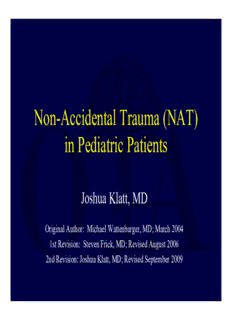
Non-Accidental Trauma (NAT) PDF
Preview Non-Accidental Trauma (NAT)
Non-Accidental Trauma (NAT) in Pediatric Patients Joshua Klatt, MD Original Author: Michael Wattenbarger, MD; March 2004 1st Revision: Steven Frick, MD; Revised August 2006 2nd Revision: Joshua Klatt, MD; Revised September 2009 Overview • Definitions • Differential Diagnosis • History • Clinical Features • Epidemiology – Nonorthopaedic Features – Orthopaedic Features • Evaluation • Management • Imaging • Summary Definitions • Federal law identifies minimum set of acts that characterize maltreatment • Defines child abuse and neglect as: – ‘at a minimum, any act or failure to act resulting in imminent risk of serious harm, death, serious physical or emotional harm, sexual abuse, or exploitation of a child by a parent or caretaker who is responsible for the child’s welfare’ Definitions • 4 Types – Physical abuse • Infliction of physical injury as a result of punching, beating, kicking, biting, burning, shaking, throwing, or otherwise harming a child with or without intention – Neglect – Sexual abuse – Emotional abuse History • Writings from 1st and 2nd century A.D. describe afflictions of children who may have been stricken intentionally • Tardieu, 1860 (Paris) – Published 1st article on mal-treatment of children – Detailed clinical findings, including description of fractures • Ingraham & Matson, 1944 – Suggested traumatic origin for subdural hematomas in infants, rather than infectious etiology History • Caffey, 1946 (NY) – Radiologist who published 1st systematic review of now well- recognized syndrome (AJR) – 6 children with chronic subdurals and 23 long bone fractures – Subsequently more systematic evaluation and study • Kempe, 1962 – Coined term ‘Battered Child Syndrome’ – Described constellation of physical findings of children who have been abused with discrepancy in reported history • Failure to thrive • Subdural hematomas • Multiple soft-tissue and bony injuries • Poor hygiene – Greatly increased public awareness, leading to improved legislation Epidemiology Inconsistencies in reporting and variation in definitions make it difficult to precisely determine prevalence and track trends Epidemiology: How widespread a problem? • 1 - 1.5% of children are abused per year • In 2005, 3.6 million investigations – 899,000 known cases – 1460 deaths • Estimates suggest that only 50-60% of cases of death due to neglect or abuse are actually recorded as such Epidemiology National Child Abuse and Neglect Data System (NCANDS) 2007 • Neglect 59% • Multiple types 13% • Physical abuse 11% • Sexual abuse 8% • Emotional maltreatment 4% • Medical neglect < 1% Epidemiology National Child Abuse and Neglect Data System (NCANDS) 2007 • Perpetrators (non-fatal cases) – Parents 80% • Mother only 39% • Father only 18% • Both 17% – Unknown 10% – Male relative 3% – Female relative 2% – Partner of parent 3%
Description: